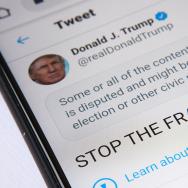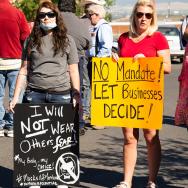Americans who lived near chapters of the far-right Proud Boys organization were more likely to have attended the Jan. 6 rally that turned into a riot on the U.S. Capitol, according to a new research from a University of Chicago scholar.
In a new working paper, Asst. Prof. Austin Wright of the Harris School of Public Policy and David Van Dijcke of the University of Michigan determined that rally participants were more likely to have traveled to the Capitol from Trump-voting “islands,” where residents are surrounded by neighborhoods with higher numbers of Biden supporters.
Wright also found that these areas were located near regional chapters of the Proud Boys, which has been designated a hate group by the Southern Poverty Law Center and a terrorist group by the Canadian government.
By relying on a rich mix of granular data, including cell phone movement, community-level voting patterns and social media activity, Wright and his co-author studied the factors associated with participation in the Jan. 6 events.
“What we found is that proximity to Proud Boy chapters and local levels of engagement with misinformation posted on Parler, the exiled social media platform popular with the far right, are robustly linked to participation in the Capitol rally,” said Wright, a leading scholar of political violence. “Social isolation and the perception of being threatened by neighboring areas that largely hold opposing political views also played a significant role in who was there.”
Released by the Becker Friedman Institute for Economics at UChicago, the paper sheds important new light on our understanding of how communities involved in mass-scale events, even ones that begin peacefully, escalate into violent insurrection. Wright and Van Dijcke find that participation in the “March to Save America” was stronger among communities that feel politically isolated—surrounded by supporters of the Democratic Party—more so than among less politically isolated, predominantly Republican areas.
These finding build on the knowledge base of studies examining the effect of intergroup contact and how such contact predicts resulting collective action. Previous work has examined the ramifications of contact between LGBTQ and heterosexual students, and between white and non-white Americans. Scholars have also studied intergroup contact in the Kurdish-Turkish and Northern Ireland conflicts, and the divide between pro-ISIS and anti-Muslim sentiments in Western Europe.
“The study of what motivates collective action is crucial for policymakers to understand not only exploring situations where protests remain peaceful, but all the more so when they escalate into violence, and when non-violent strategies devolve into riots and armed insurrection,” Wright concluded. “It will be interesting to see if and how the events of Jan. 6 reshape U.S. political institutions.”
—This story was first published by the Harris School of Public Policy.

